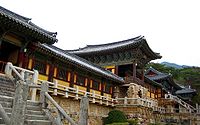- North South States Period
-
North South States Period Hangul 남북국시대 Hanja 南北國時代 Revised Romanization Nambukgukshidae McCune–Reischauer Nampukkuksitae History of Korea 
This article is part of a seriesPrehistory Jeulmun period Mumun period Gojoseon ?–108 BCE Wiman Joseon 194 BCE–108 BCE Proto–Three Kingdoms 300–57 BCE Buyeo, Goguryeo, Okjeo, Dongye Jin state, Samhan (Ma, Byeon, Jin) Four Commanderies of Han Three Kingdoms 57 BCE–668 Goguryeo 37 BCE–668 Baekje 18 BCE–660 Silla 57 BCE–935 Gaya 42–562 North and South States 698–926 Unified Silla 668–935 Balhae 698–926 Later Three Kingdoms 892–936 Taebong, Hubaekje, Silla Goryeo Dynasty 918–1392 Joseon Dynasty 1392–1897 Korean Empire 1897–1910 Colonial Korea 1910–1945 Provisional Gov't 1919–1948 Division of Korea 1945–present North, South Korea 1948–present By topic Timeline List of monarchs Linguistic history Science and technology history Art history Military history Naval history
Korea Portal
North South States Period (698 CE – 926 CE) refers to the period in Korean history when Silla and Balhae coexisted in the south and north of the peninsula, respectively.[1][2]
Contents
Unified Silla
Main article: Unified SillaAfter the unification wars, the Tang Dynasty established territories in the former Goguryeo, and began to administer and establish communities in Baekje. Silla attacked the Chinese in Baekje and northern Korea in 671.
The Tang Dynasty then invaded Silla in 674 but Silla defeated the Tang army in the north. Silla drove the Tang forces out of the peninsula by 676 to achieve unification of most of the Three Kingdoms.
Korean arts flourished dramatically and Buddhism became a large part of Silla culture. Buddhist monasteries such as the Bulguksa are examples of advanced Korean architecture and Buddhist influence. State-sponsored art and architecture from this period include Hwangnyongsa Temple, Bunhwangsa Temple, and Seokguram Grotto, a World Heritage Site.
Silla began to experience political troubles in 780. This severely weakened Silla and soon thereafter, descendants of the former Baekje established Later Baekje. In the north, rebels revived Goguryeo, beginning the Later Three Kingdoms period.
Unified Silla lasted for 267 years until, under King Gyeongsun, it was absorbed by Goryeo in 935.[3]
Ballhae
Main article: BalhaeBalhae was founded after Goguryeo had fallen. It was founded in the northern part of former lands of Goguryeo by Dae Joyeong, a former Goguryeo general. Balhae controlled the northern areas of the Korean Peninsula, much of Manchuria, and expanded into present-day Russian Maritime Province. Balhae styled itself as Goguryeo's successor state.
In a time of relative peace and stability in the region, Balhae flourished,especially during the long reign of the third Emperor Mun (r. 737-793) and King Seon. However, Balhae was severely weakened by the tenth century, and the Khitan Liao Dynasty conquered Balhae in 926.
Goryeo absorbed some Balhae territory and received Balhae refugees, including the crown prince and the royal family, but compiled no known histories of Balhae either. The eighteenth century Joseon dynasty historian Yu Deukgong advocated the proper study of Balhae as part of Korean history, and coined the term "North and South States Period" to refer to this era.
Language
Due to the lack of linguistic evidence, it is difficult to make a definitive conclusion for the linguistic relation between Balhae and Silla language. Though Shoku Nihongi, an ancient Japanese record, implies the close relationship between the Balhae and Silla language: a student sent from Silla to Japan for an interpreter training of Japanese language, assisted a diplomatic envoy from Balhae in communicating during the Japanese court audience.
See also
References
- ^ Encyclopedia, Naver, http://100.naver.com/100.nhn?docid=35519.
- ^ Korean Britannica Encyclopedia, Daum, http://enc.daum.net/dic100/viewContents.do?&m=all&articleID=b03n3235a.
- ^ King, KR: Roots info, http://www.rootsinfo.co.kr/history/king08.html, "Wang Geon changed the name of dynasty to Goryeo".
Categories:
Wikimedia Foundation. 2010.
